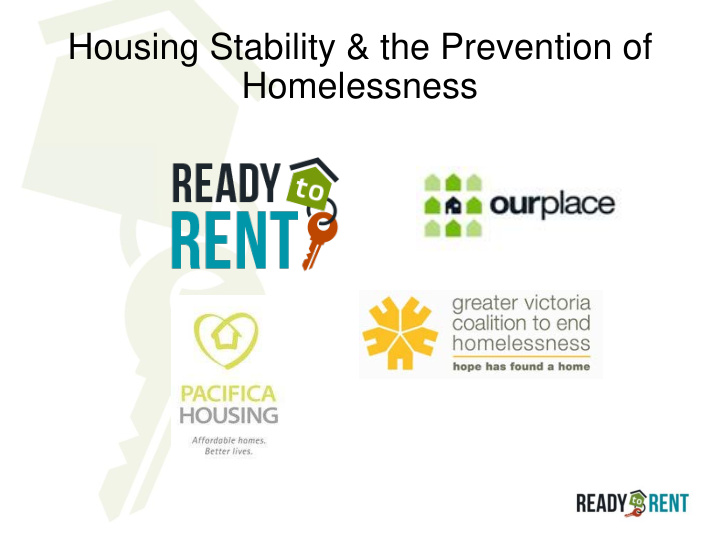



Housing Stability & the Prevention of Homelessness
Preventing Homelessness
Primary Prevention
Secondary Prevention
Tertiary Prevention
Lessons Learned from Suicide Prevention • Integration of education • Community-wide approach and plan • Targeting • Focusing on root causes • Continual evaluation and feedback
Prevention Approaches Underlying Best Practices Root causes Targeting and early intervention Community-wide approach and plan: integration of services Continuous evaluation and feedback
Best Practices in Action 1.Overview of approach 2.The best practices learned 3.The challenges experienced 4.Advice should you want to try this at home
Vision : community well-being through housing education and support Mission : to deliver housing education and related services
Education, certificate and supports
Increasing Housing Stability
Education is key... Over 2000 participants since 2009 100% said knowledge increased 92% said confidence increased 86% said maintaining their housing was easier 72% said finding a place to rent was easier 66% used the RentSmart certificate 70% said it helped them in securing their housing 2015 P Participant I Impa pact S Survey ey
Best Practices: Population-Specific
Challenges: Population-specific Education seems simple Prevention can be hard to measure
Prevention Approaches Underlying Best Practices Root causes Targeting and early intervention Community-wide approach and plan: integration of services Continuous evaluation and feedback
Prevention Approaches Underlying Best Practices Root causes Targeting and early intervention Community-wide approach and plan: integration of services Continuous evaluation and feedback
Homelessness Prevention Fund
Prevention Approaches Underlying Best Practices Root causes Targeting and early intervention Community-wide approach and plan: integration of services Continuous evaluation and feedback
Greater Victoria Coalition to End Homelessness Housing Stability and Prevention of Homelessness System Response Don Elliott Executive Director
Organizational Overview • Formed in 2008 . • Consists of service providers, non-profit organizations, all levels of government, businesses, postsecondary institutions, the faith community, people with a lived experience of homelessness, and members of the community. • Approximately 41 distinct organizations . • Vision: A Region without Homelessness • Mission 1. To ensure appropriate solutions are in place to serve those individuals experiencing chronic homelessness in the Capital Region. 2. To ensure all people facing homelessness in the Capital Region have access to safe, affordable, appropriate, long-term housing.
Role in Stability & Prevention • Primary Prevention • Regional Housing First Program (affordable component) • Aboriginal Coalition to End Homelessness Society • Secondary Prevention • Homelessness Prevention Fund • Landlord Liaison Services • Housing Stability Policy • Tertiary Prevention • Regional Housing First Program (supported component) • Priority One Task Force
System Response
System Response
System Response
System Response
System Response
Challenges • Coalition Identity – Different meanings to different stakeholders. • Tensions Between Institutional Logics – Social justice, root causes, efficient action, planning and community accountability. • Coordination and Communication – Essential across all stakeholders. • Ensuring Inclusivity – Time consuming and complex, but critical to achieving objectives. • Funding – Few programs support region-wide planning and collaboration activities.
Takeaways • Clear goals and targets. • Region-wide homelessness intervention system that includes targeted prevention strategies. • Robust information sharing systems across agencies. • High degree of collaboration among different stakeholders. • Knowledge transfer and shared learning. • Resources available in support of collective efforts.
Prevention Approaches Underlying Best Practices Root causes Targeting and early intervention Community-wide approach and plan: integration of services Continuous evaluation and feedback
Our Focus To improve policy, practice and community connections for young people transitioning from foster care to adulthood.
A Good Life • HOME • RELATIONSHIPS • WORK • EDUCATION • WELL-BEING • COMMUNITY
Our Approach 1. Youth engagement 2. Community capacity 3. Shared Learning, Evaluation & Research 4. Communications and public engagement
Shared Learning, Evaluation & Research
Principles • Through our work, we want to demonstrate what success can look like for young people transitioning out of foster care – at the individual youth, community and system levels. • We want our work and what we are learning to influence positive change in policy and practice. • We want to contribute to and build the body of evidence showing what works and what does not work (and in what context) • We are open to emergent learning, to uncovering barriers and exploring opportunities • We want learning to underpin everything we do, to be an inherent component of all of our strategies and activities • We embrace a developmental evaluation approach, which supports adaptation in complex, uncertain and dynamic conditions
“No go. The evaluation committee said it doesn’t meet utility specs. They want something linear, stable, controllable, and targeted to reach a pre-set destination. They couldn’t see any use for this.”
Questions, thoughts and feedback… Thank you!
Recommend
More recommend